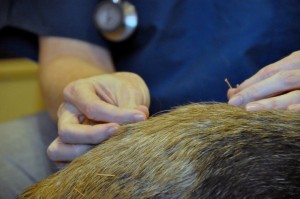
Acupuncture is an ancient Chinese medical technique used for over 3,000 years in China, Japan and Korea. Needles are placed in designated points to effect various changes in the body to decrease pain, help heal injuries or disease conditions, stimulate or regulate immune responses, and/or decrease anxiety or behavioral issues. During her career, Dr. Royal has treated dogs, cats, ferrets, rabbits, guinea pigs, birds, camels, a zebra, and an elephant with acupuncture!
Acupuncture has been shown to increase blood and lymphatic flow to tissues, stimulate nerve function, increase the release of neurotransmitters and pain modulators, influence inflammatory responses and help the release hormones. It can be used in a variety of conditions.
Common conditions that respond well to acupuncture include:
- Musculoskeletal conditions (arthritis, spinal disease, trauma, muscle atrophy problems)
- Immune system disorders (allergic dermatitis, chronic allergic diseases, immune diseases, lick granulomas, chronic skin conditions)
- Neurologic problems (nerve injury, paresis, paralysis, degenerative neurologic conditions)
- Systemic diseases/urologic diseases (chronic kidney disease, liver disease, incontinence, bladder problems)
Acupuncture includes treatments using:
- Dry needles to stimulate points directly
- Laser acupuncture to stimulate points
- Aquapuncture, which uses a liquid (such as vitamin B12, Traumeel, saline or other appropriate substances) injected at acupuncture sites, rather than leaving needles in place
- Electroacupuncture to stimulate points with a mild electric current
- Acupressure used both in the facility and points can be shown to owners for home use
- Moxibustion to stimulate points or areas using heat provided by a coal made of Chinese herbs
Commonly asked questions about acupuncture:
Q: Is an acupuncture treatment painful for the animal?
A: Most needles are placed without a reaction from the animals. The needles are much thinner and smaller than hypodermic needles used for injections. Occasionally animals feel some discomfort with the insertion of the needle, but it is usually a brief response to the stimulation. After needles are placed, many patients relax and even fall asleep during the treatment.
Q: How do you keep the animal still for the treatment?
A: Patients do not have to stay still for the treatment. Some animals pace or fidget during needle placement and treatment. Keeping the needles in place is important, so a resting animal is preferable, but not always possible. Dr. Royal does acupuncture on animals that can’t be restrained (camels, zebra) and the treatments are still very effective. For dogs and cats it is sometimes useful to hold their collars or sit with them to keep them from shaking out the needles before the treatment is completed.
Q: How long does a treatment take?
A: Acupuncture needles are left in place from just a few seconds to 30 minutes depending on the points chosen, the needs of the animal and the condition being treated. Sometimes Aquapuncture is employed (injecting a fluid – usually Vitamin B12 in the points to stimulate them instead of needling the points), and the treatment is finished as soon as the injections are given.
Q: How frequently should treatments be done?
A: Most treatment protocols begin with 3-6 treatments once a week. Acupuncture works more slowly than traditional medications, but the effects last longer with each treatment. After an initial series of treatments, sometimes more treatments are not necessary. If conditions merit chronic treatment, we try to determine the best interval for each animal to maintain their comfort and health and minimize the frequency of the treatments. Chronic treatment intervals can vary from every week to every 6 months.
Q: When can I expect to see results?
A: Results can sometimes be seen immediately, but often it takes from 2 to 6 treatments (depending on the condition) before appreciable differences are noted. Acupuncture is a treatment that uses the body’s own resources to effect change, therefore the condition of the animal affects the speed of the recovery, but the effects are often longer lasting and have fewer side effects than most pharmaceutical cures.
Q: What are common side effects of acupuncture?
A: Side effects of acupuncture are few, not common, and usually minor. They include:
- Possible bruising or bleeding at the site of the needle
- Possible organ puncture
- Needle breakage
- Tiredness (usually doesn’t last more than 24 hours in most patients)
- Temporary worsening of signs before improvement is seen (also not more than 24 hours)
While these side effects can be seen, they are rare.
